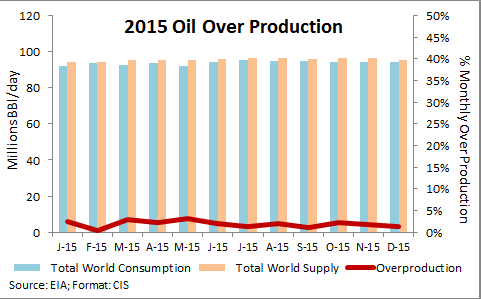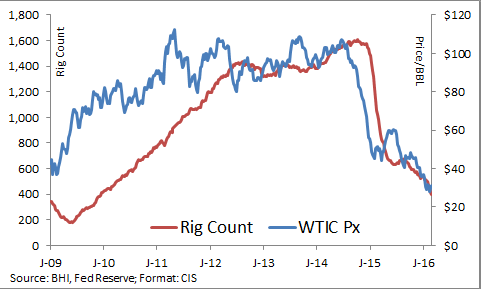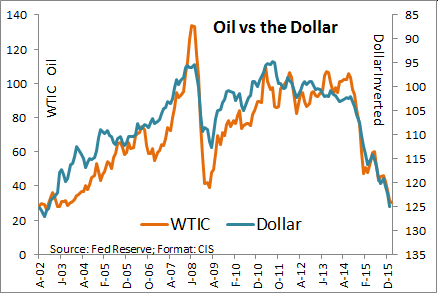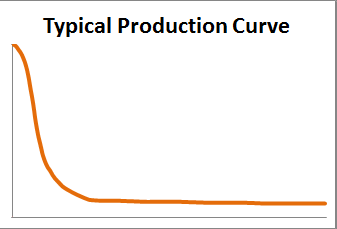What the U.S. Dollar Can Tell Investors About Oil Prices
Watch the Fed and U.S. dollar to figure out if and when oil may bottom and start to recover.

Won't $0.99 per gallon of gasoline be great? That is what some "experts" predict for the summer of 2016. Maybe it will happen; maybe it won't. What is for sure is that the price of oil has collapsed over the past year, and many U.S. oil companies have gone out of business.
So why did the price of oil drop so much? Was it overproduction from Saudi Arabia? Was it declining global consumption?
3 Myths About Why Oil Prices Dropped
1. Saudi Arabia's overproduction.
Yes, it is true that Saudi Arabian oil producers have been increasing output. But since the price of oil collapsed, the Organization of the Petroleum Exporting Countries (OPEC) increased its production by only 3.95%, according to data from the U.S. Energy Information Administration (EIA). World production was up 2.23% during the same period, according to the EIA. So yes, OPEC was producing oil at a faster rate than the rest of the world, but does a 3.95% increase really translate into a 75% decline in the price of oil? We don't think a 3.95% increase in supply justifies a 75% price decline. So it must be something else.

Sign up for Kiplinger’s Free E-Newsletters
Profit and prosper with the best of expert advice on investing, taxes, retirement, personal finance and more - straight to your e-mail.
Profit and prosper with the best of expert advice - straight to your e-mail.

2. Consumption has dropped significantly.
Where? In the U.S.? China? Europe? EIA data shows that global consumption since the peak price in June 2014 has been up 0.89% (or about 0.50%, annualized). Yes, this growth in annual consumption is slower than the average since 2000, which has been 1.27% annually, according to data from oil giant BP. So since mid 2014, consumption did not decline. It actually increased, albeit at a rate about 0.77% slower than average. Does a 0.77% decline in the growth rate really justify a 75% drop in the price of oil? No, we don't think so either. So it must be something else.
3. U.S. oil companies' troubles.
Rig counts have collapsed over the past year or so. According to oil field services company Baker Hughes, the number of rigs dropped from 1,609 in October 2014 to 400 in February 2016, a decline of 75%. This crash in rig counts indicates that U.S. oil companies didn't start failing until October 2014 at the earliest. But the price of oil started crashing earlier, in June 2014. Rig counts dropped due to the price of oil, not the other way around. (Of course some went under for reasons other than the oil price drop.)

Why Oil Prices Really Collapsed
In reality, the most likely candidate for why oil prices collapsed is the rise of the U.S. dollar. Oil is priced in dollars. And since June 2014, according to the Federal Reserve, the dollar has rallied 21%. As the chart below shows, if you invert the dollar, it parallels the decline in the price of oil. This is most likely the catalyst for the price decline.

So why did the U.S. dollar rally? Wasn't it the Fed's mandate to maintain price stability? Besides hurting the price of oil, a rising dollar hurts U.S. exports. Since June 2014, exports have declined 10%, according to the Federal Reserve's own data. Since the rising dollar hurt the price of oil, it has also decimated the oil business in the U.S.
Why did the Fed drop the ball on the dollar? Did they not see how it would impact the price of oil? They intervened to keep interest rates low and to keep stock prices from collapsing. But what happened with the U.S. dollar? This oversight indicates a lack of leadership and control at the Fed.
The fallout from the U.S. dollar's rally has been the decline in the price of many commodities, not just oil, troubles in the emerging markets since much of their debt was priced in U.S. dollars and a decline in U.S. exports. In my opinion, the Fed is directly responsible for the U.S. dollar's rally and the resulting problems.
So what does this mean? Eventually the dollar should come back to where it belongs, at a level much lower than the current price. This should benefit exports, the U.S. economy in general, the price of oil and other commodities and the emerging markets. But in the meantime, the Fed may allow the dollar to rally further. So the key is to watch the U.S. dollar.
What does an investor do? Realize that the current situation with anything that is related to the price of the U.S. dollar is in a temporary, artificially manipulated state. However, oil may bottom, and maybe even recover, sooner than many think. This is due to the production curve of oil wells.

Many people think that once a well is drilled, oil comes out in a continuous flow. That isn't the case. The typical production curve for a well is a steep drop in the first few years until it flattens out, producing maybe only 10% to 20% of the first year's production each year for the next 20 years or more.
If you look at the chart earlier in this column that compares the number of rigs with the price of oil, you will see that the rig count peaked a little over a year ago. This means the production of the last rigs that came online may soon decline rapidly. After years of rising production, the U.S. could see declining production in the next few months. This could put a floor on the price of oil. If the production decline is steep enough, it may actually offset the U.S. dollar's rally. Even if it does continue to rally, the impact on the price of oil may not be as bad as it has been over the past 18 months.
The key is still the U.S. dollar, but if U.S. oil production starts to decline, it may signal that the worst for oil prices may be over.
John Riley, registered Research Analyst and the Chief Investment Strategist at CIS, has been defending his clients from the surprises Wall Street misses since 1999.
Disclosure: Third party posts do not reflect the views of Cantella & Co Inc. or Cornerstone Investment Services, LLC. Any links to third party sites are believed to be reliable but have not been independently reviewed by Cantella & Co. Inc or Cornerstone Investment Services, LLC. Securities offered through Cantella & Co., Inc., Member FINRA/SIPC. Advisory Services offered through Cornerstone Investment Services, LLC's RIA. Please refer to my website for states in which I am registered.
Get Kiplinger Today newsletter — free
Profit and prosper with the best of Kiplinger's advice on investing, taxes, retirement, personal finance and much more. Delivered daily. Enter your email in the box and click Sign Me Up.

In 1999, John Riley established Cornerstone Investment Services to offer investors an alternative to Wall Street. He is unique among financial advisers for having passed the Series 86 and 87 exams to become a registered Research Analyst. Since breaking free of the crowd, John has been able to manage clients' money in a way that prepares them for the trends he sees in the markets and the surprises Wall Street misses.
-
 6 Stunning Waterfront Homes for Sale Around the US
6 Stunning Waterfront Homes for Sale Around the USFrom private peninsulas to lakes, bayous and beyond, Kiplinger's "Listed" series brings you another selection of dream homes for sale on the waterfront.
By Charlotte Gorbold Published
-
 Six Reasons to Disinherit Someone and How to Do It
Six Reasons to Disinherit Someone and How to Do ItWhether you're navigating a second marriage, dealing with an estranged relative or leaving your assets to charity, there are reasons to disinherit someone. Here's how.
By Donna LeValley Published
-
 Should You Still Wait Until 70 to Claim Social Security?
Should You Still Wait Until 70 to Claim Social Security?Delaying Social Security until age 70 will increase your benefits. But with shortages ahead, and talk of cuts, is there a case for claiming sooner?
By Evan T. Beach, CFP®, AWMA® Published
-
 Retirement Planning for Couples: How to Plan to Be So Happy Together
Retirement Planning for Couples: How to Plan to Be So Happy TogetherPlanning for retirement as a couple is a team sport that takes open communication, thoughtful planning and a solid financial strategy.
By Andrew Rosen, CFP®, CEP Published
-
 Market Turmoil: What History Tells Us About Current Volatility
Market Turmoil: What History Tells Us About Current VolatilityThis up-and-down uncertainty is nerve-racking, but a look back at previous downturns shows that the markets are resilient. Here's how to ride out the turmoil.
By Michael Aloi, CFP® Published
-
 Home Insurance: How to Cut Costs Without Losing Coverage
Home Insurance: How to Cut Costs Without Losing CoverageNatural disasters are causing home insurance premiums to soar, but don't risk dropping your coverage completely when there are ways to keep costs down.
By Jared Elson, Investment Adviser Published
-
 Markets Roller Coaster: Resist the Urge to Make Big Changes
Markets Roller Coaster: Resist the Urge to Make Big ChangesYou could do more harm than good if you react emotionally to volatility. Instead, consider tax-loss harvesting, Roth conversions and how to plan for next time.
By Frank J. Legan Published
-
 Why Homeowners Insurance Has Gotten So Very Expensive
Why Homeowners Insurance Has Gotten So Very ExpensiveThe home insurance industry is seeing more frequent and bigger claims because of weather, wildfires and other natural disasters.
By Karl Susman, CPCU, LUTCF, CIC, CSFP, CFS, CPIA, AAI-M, PLCS Published
-
 Going Through Probate? How to Find the Right Attorney
Going Through Probate? How to Find the Right AttorneyJust having the skills and experience to do the job isn't enough. The probate attorney you hire needs to have the right temperament for your particular case.
By John R. Silva, Esq. Published
-
 Widow's Penalty: Three Ways to Protect Your Finances
Widow's Penalty: Three Ways to Protect Your FinancesHigher Medicare premiums, smaller Social Security payments, bigger tax bills … Financial changes can hit hard when a spouse dies. How to counter the blow.
By Ashley Terrell, IAR Published